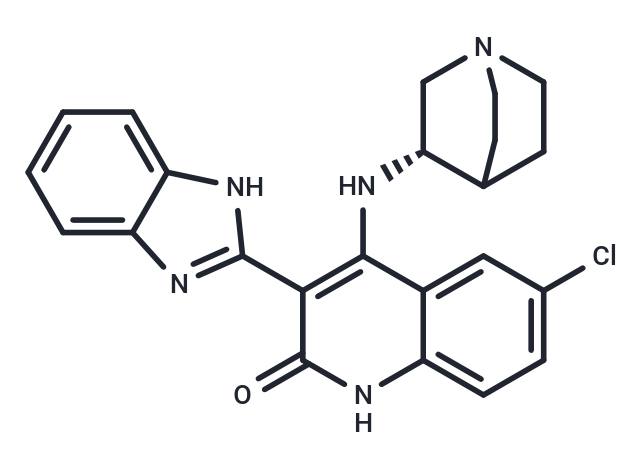Shopping Cart
- Remove All
 Your shopping cart is currently empty
Your shopping cart is currently empty

CHIR-124 is an effective Chk1 inhibitor (IC50: 0.3 nM). It has 2, 000-fold selectivity against Chk2, 500- to 5, 000-fold less activity against Cdc2 and CDK2/4.

| Pack Size | Price | Availability | Quantity |
|---|---|---|---|
| 1 mg | $35 | In Stock | |
| 2 mg | $47 | In Stock | |
| 5 mg | $74 | In Stock | |
| 10 mg | $106 | In Stock | |
| 25 mg | $173 | In Stock | |
| 50 mg | $253 | In Stock | |
| 100 mg | $377 | In Stock | |
| 1 mL x 10 mM (in DMSO) | $79 | In Stock |
| Description | CHIR-124 is an effective Chk1 inhibitor (IC50: 0.3 nM). It has 2, 000-fold selectivity against Chk2, 500- to 5, 000-fold less activity against Cdc2 and CDK2/4. |
| Targets&IC50 | Chk1:0.3 nM |
| In vitro | CHIR-124 is a quinolone-based small molecule that is structurally unrelated to other known inhibitors of Chk1. CHIR-124 interacts synergistically with topoisomerase poisons (e.g., Camptothecin or SN-38) in causing growth inhibition in a variety of cancer cell lines, including breast carcinoma (MDA-MB-231 and MDA-MB-435) and colon carcinoma (SW-620 and Colo205), all of which contains the mutant p53 gene. CHIR-124 abrogates the SN-38-induced S and G2-M checkpoints and potentiates apoptosis in MDA-MD-435 breast cancer cells. The abrogation of the G2-Mcheckpoint and induction of apoptosis by CHIR-124 are enhanced by the loss of p53. [1] CHIR-124 also potently targets other kinases such as PDGFR and Flt3 with IC50 of 6.6 nM and 5.8 nM, respectively. [2] |
| In vivo | CHIR-124 potentiates the growth inhibitory effects of Irinotecan by abrogating the G2-M checkpoint and increasing tumor apoptosis in an orthotopic breast cancer xenograft model. |
| Kinase Assay | Chk1 Assay: For the Chk1 assay, the kinase domain is expressed in Sf9 insect cells, and a biotinylated cdc25c peptide containing the consensus Chk1/Chk2 phosphorylation site (*)(biotin-[AHX]SGSGS*GLYRSPSMP-ENLNRPR[CONH2]) is used as the substrate. A dilution series of CHIR-124 is mixed with a kinase reaction buffer containing a final concentration of 30 mM Tris-HCl (pH 7.5), 10 mM MgCl2, 2 mM DTT, 4 mM EDTA, 25 mMβ-glycerophosphate, 5 mM MnCl2, 0.01% bovine serum albumin, 1.35 nM CHK1 kinase domain, 0.5 μM peptide substrate, and 1 AM unlabeled ATP, plus 5 nM 33Pγ-labeled ATP (specific activity = 2,000 Ci/mmol). Reactions and detection of the phosphate transfer are carried out by a radioactive method. Reactions are incubated at room temperature for 1 to 4 hours and the phosphorylated peptide captured on streptavidin-coated microtiter plates containing stop reaction buffer (25 mM EDTA [ethylenediaminetetraacetic acid], 50 mMHEPES, pH 7.5). Phosphorylated peptide is measured with the DELFIA TRF system using a Europium-labeled anti-phosphotyrosine antibody PT66. The concentration of CHIR-124 for IC50 is calculated using nonlinear regression with XL-Fit data analysis software. |
| Cell Research | MDA-MB-231, MDA-MB-435, SW-620, and COLO 205 cells in log-phase are plated into 96-well microplates. CHIR-124 is serially diluted in the presence of six different concentrations of Camptothecin or 0 nM camptothecin. Camptothecin is also serially diluted in the absence of CHIR-124. CHIR-124 is added to cells in 96-well dishes and incubated at 37 °C for 48 hours. Each treatment condition is done in triplicate. Cell proliferation is monitored by the 3-(4,5-dimethylthiazol-2-yl)-5- (3-carboxymethoxyphenyl)-2-(4-sulfophenyl)-2H-tetrazolium (MTS), inner salt assay. MTS inner salt is added to the microplates, which are incubated for another 3 hours, and absorbance at 490 nm is read on a plate reader. The concentrations of each drug in the combinations required to produce 50% inhibition are plotted to generate the isoboles. Isobologram analysis of drug interaction is based the equation of Loewe additivity (1= D A /IC50, A + DB/IC50, B), where IC50, A and IC50, B are the concentrations of drugs to result in 50% inhibition for each drug alone, and DA and DB are concentrations of each drug in the combination that yield 50% overall inhibition. A diagonal line indicating Loewe additivity is included in each graph. Data points that fall below the line indicate synergy, whereas those that fall above the line will indicate antagonism(Only for Reference) |
| Alias | CHIR124, CHIR 124 |
| Molecular Weight | 419.91 |
| Formula | C23H22ClN5O |
| Cas No. | 405168-58-3 |
| Smiles | Clc1ccc2[nH]c(=O)c(-c3nc4ccccc4[nH]3)c(N[C@@H]3CN4CCC3CC4)c2c1 |
| Relative Density. | 1.46 g/cm3 |
| Storage | store at low temperature,keep away from direct sunlight | Powder: -20°C for 3 years | In solvent: -80°C for 1 year | Shipping with blue ice. | |||||||||||||||||||||||||
| Solubility Information | H2O: < 1 mg/mL (insoluble or slightly soluble) Ethanol: < 1 mg/mL (insoluble or slightly soluble) DMSO: 14 mg/mL (33.34 mM), Sonication is recommended. | |||||||||||||||||||||||||
Solution Preparation Table | ||||||||||||||||||||||||||
DMSO
| ||||||||||||||||||||||||||

Copyright © 2015-2025 TargetMol Chemicals Inc. All Rights Reserved.